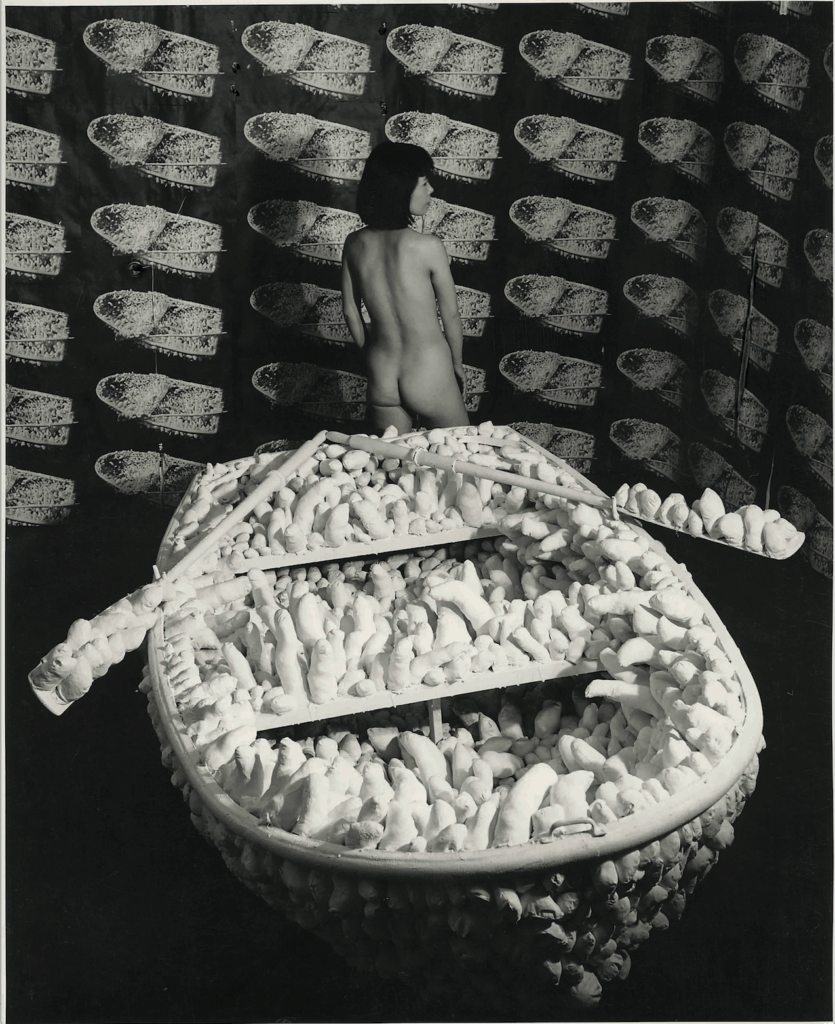
Yayoi Kusama was born in Japan in 1929. Her art career in Japan began slowly due to strict social and gender roles present in Japanese culture. She moved to New York in 1958 where her career blossomed. She gained considerable notoriety during the Pop art Movement and overtime became an enormous success across the globe. One of her most notable successes in the art world was when she was the first and only woman ever selected as Japan’s sole representative at the Venice biennial. She started to paint using polka dots and nets as motifs at around age ten and created fantastic paintings in watercolors, pastels, and oils. Later in her career, she created large paintings, soft sculptures, and environmental sculptures using mirrors and electric lights. She also created installations such as; body painting festivals, fashion shows, and anti-war demonstrations. Launched media-related activities such as film production and newspaper publication.
Her style, in general, is characterized by a polka dot obsession, polka dot environments, domestic objects, large scale installations. Her work was often “encrusted with stuffed phallic projections anticipated feminist challenges to the structures of sexual difference, while her uninhibited performances and the hallucinatory obsessive qualities of her practice attracted widespread attention”(Chadwick). Her childhood explains her artistic motivation. Yayoi Kusama tells the story of how when she was a little girl she had a hallucination that freaked her out. She was in a field of flowers when they all started talking to her! The heads of flowers were like dots that went on as far as she could see, and she felt as if she was disappearing or as she calls it ‘self-obliterating’- into this field of endless dots. She also had a strict mother who was not supportive of her art and abusive to her and a father who was a serial adulterer womanizer. These experiences and her history with mental illness have impacted her work then, and still to this day.
She primarily worked in series’ and some that are noteworthy are, “Self-Obliteration”, which she describes by saying: “by obliterating one’s individual self, one returns to the infinite universe…” (Turner). Another is, “Aggregation: One Thousand Boats”, which was a rowboat covered in soft phallic objects and covered the room in 999 images of the rowboat. Another series she created was, “Infinity Rooms” which were mirrored rooms with LED lights or painted objects with dots that reflected against the mirrors to create an infinite environment overcome by dots. By adding all-over marks and dots to her paintings, drawings, objects, and clothes she feels as if she is making them (and herself) melt into, and become part of, the bigger universe. She said: “Our earth is only one polka dot among a million stars in the cosmos. Polka dots are a way to infinity. When we obliterate nature and our bodies with polka dots, we become part of the unity of our environment”(“Who Is Yayoi Kusama?…”).
After some time in New York and being massively successful, she returned to Japan in 1973 and voluntarily moved into a mental institution where she continued creating art. Her work re-emerged into the art world in 1993 with a string of solo international exhibitions. She continues to be incredibly famous and well observed.
“Self-Obliteration”

“Aggregation: One Thousand Boats”

“Infinity room”

Bibliography:
“Biography: Yayoi Kusama.” Biography | Yayoi Kusama, Yayoi Kusama Inc., 2019, yayoi-kusama.jp/e/biography/index.html.
Chadwick, Whitney. Women, Art, and Society. Sixth Edition, Thames and Hudson, 2020.
Turner, Grady T. “Yayoi Kusama by Grady T. Turner – BOMB Magazine.” Yayoi Kusama – BOMB Magazine, BOMB Magazine, 1 Jan. 1999, bombmagazine.org/articles/yayoi-kusama/.
“Who Is Yayoi Kusama? – Who Are They?” Tate Kids, Tate, www.tate.org.uk/kids/explore/who-is/who-yayoi-kusama.